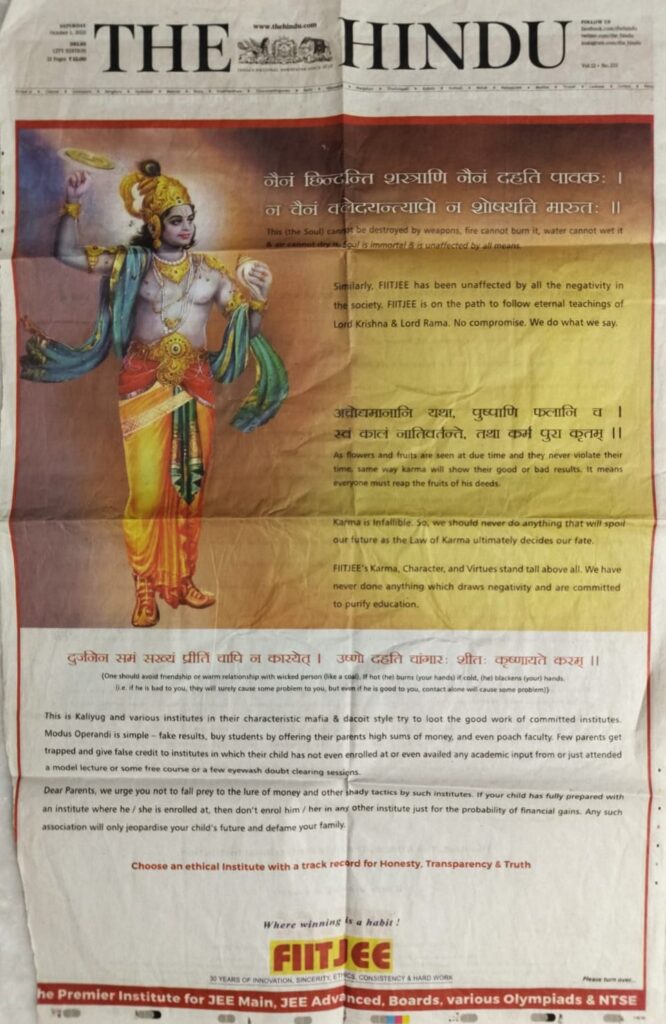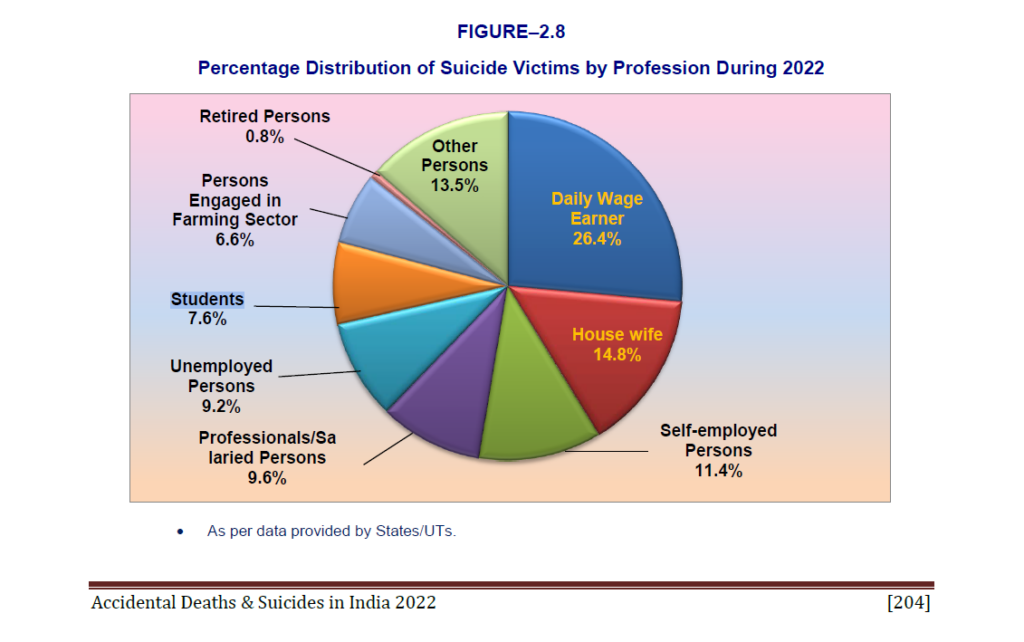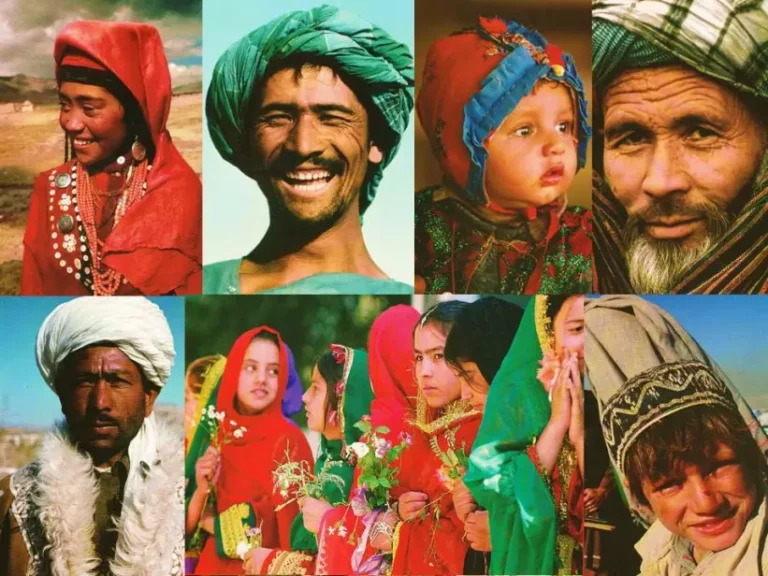Coaching Classes: What do you call a group of parrots?
Abhiram Kuchibhotla (@kalraavn) is a humanities graduate and communications specialist based in Delhi, India. His work can be found at Subnivean, The Remnant Archive, and Doing Sociology.
Flashbacks of the Marked
There have never been more ways for us to see ads – which is why we ignore most of them. But some inevitably scar the mind, like the one I saw on the front of a major newspaper recently. No one in India can claim that they’ve never seen an ad about a coaching class before (let’s just refer to this one as ‘CC’); but what sort of person/team could have come up with this one?

There were three Sanskrit stanzas and their translations in the ad. There was a large illustration of Lord Krishna left of them, sudarshan chakra and conch in hands. Dressed in the usual accoutrements – gold crown, necklace, armlets, gem-encrusted vaddanam, yellow dhoti, and huge mojaris. As expected, none of the translations indicated what the ad was about. Or what CC was trying to say through it. The third and fourth verses scared anxious parents directly by claiming there was no time for them or their children to make mistakes that could ‘spoil’ futures.
Sigh. I understood then. There were family honours at risk, and there was a professor in a CC trying to tell us that it is an ethical coaching class. That was the word the ad highlighted. Which is a huge claim, sure, but I can understand where they’re coming from. They want to establish they’re not like the others. They’re sympathizing with our worries and telling us we’ve reached a state where the existence of coaching classes is normal. The new normal is being a good coaching class. Not in regards to getting marks, because a lot of them can claim that now, but morally. The kind that would follow Krishna’s teachings like the parents of their students would expect them to. And this ad? It was simply asking the latter not to enrol their children in more than one coaching class. Just in CC.
It is not my intention to trivialize or mock the determination of those who spend their days haggling teachers at doubt counters, or develop stomach problems burning the midnight oil. I know students who have suffered from anxiety, depression, body dysmorphia, behavioural disorders, and even lost loved ones during Covid only to turn up to class in a tightly-packed Maruti Omni the next day. Students whose parents emptied their savings to have them sit at the same desk I have – or to live in matchbox-sized apartments in Rajinder Nagar and go to bed with bellies filled by the desperation of knowing they’re one among millions trying to get that shot at the Good LifeTM. That is the way the Indian education system works, and neither this commentary nor the coaching classes can probably change that.

However, I fail to understand how organizations that put children in concrete cells for 12-18 hours can exercise authority by claiming they know what a child needs better than their parents do. Although there is barely any research to get a clear picture of the mental and physical toll inflicted on the youth by coaching classes, the data compiled by Accidental Deaths and Suicides in India (ADSI) catalog in 2022 may shed more light on how failing in examinations has become a major factor in such deaths, as it indicates 13,044 students committed suicide in 2022 alone, or 7.6% of the total. 35 students died by suicide every day in India. One every 40 minutes. It even states that the second-highest number of female suicides were committed by students (6,113), only lower than the number of housewives who committed suicide in the year (25,309) – which is also an insight into the state of women empowerment in the country.
Perhaps it is still a stretch to say that we have become complicit in the deaths of thousands of teenagers by funding a system to the extent that its proponents can sponsor cricket matches. No wonder they can afford to blow so much cash on gifts for toppers and poorly designed ads.
Tallest Ladder in the World
Coaching classes are actively making our school system crumble. Especially through collaborations between coaching classes and ‘dummy’ schools that cost more than college because they allow students to be coached all day long. The students go to the dummy schools on weekends to complete the only formalities that can’t be fudged – lab practicals, journals, and of course, exam results. Can’t forget the board exams. The students must top them as well. I know this because I was in a dummy school, and neither the teachers nor us students knew exactly what the heck was going on – we were all resigned to the fact that this was what our education had been reduced to. Moreover, while the average middle-class parent might only have to worry about serious financial constraints when their child is about to attend college, the economically weaker classes have to start shelling out the big bucks pretty early – if only to ensure their kids have access to the same educational resources their richer peers do. In both instances, money that is crucial to the maintenance of the Indian school system is being funnelled elsewhere.
Excel, win, succeed. What do these terms mean when used in such ads? There is no escaping the fact that there is always going to be someone doing better at whatever paradigm you choose to measure your own life by. Students who have taken ‘drops’ to prepare for an exam, or those who have done what you have done, gone ahead, studied a little, and then dropped out to study for CAT, GMAT, UPSC etc. and are still at the same stage that you are – or even worse, want to be. The pressure to outperform ninety percent of one’s friends to have a chance at the same underpaid, over-advertised ‘life-settling’ job stilts interpersonal relationships and leaves students without the ability to develop a healthy network of friends who they can discuss deep emotional issues with. Of course, this assumes possessing the abilities to express oneself or empathize with others in the first place.
In fact, the best students at the best colleges in India are also the… best depressed. Students from marginalized communities find themselves struggling at every step of the educational ladder to keep up with English-medium students, overburdened public institutions, high fees, and caste discrimination by the Brahminical patriarchs occupying authoritative positions at every ‘elite’ university. There is now a glut of Indian students who are told by employers that they do not have the adequate ‘skills’ to secure jobs despite being competent in every way the system expected them to. Forced to live on a stipend of thirty to sixty thousand rupees even if they become PhD candidates. They occupy a demographic populated by a glut of couples in their thirties who have finally found a work-life balance and begun to love – but who are also afraid to bring children into this world because they do not know if their progeny can survive it.
Parasitic Capitalism and the Simulacra of Studying
Two or three decades ago, a tuition was an understanding between two adults that they would share the effort they were making to educate their children. Share it, not leave it to the free market to turn into an exorbitantly expensive service that guarantees more marks. The quality of education has become an optional clause, fulfilled only by the rare teacher who connects with their students not on the basis of merit, but from their duty as an authority figure to provide guidance.
This is not to divide teachers into two polars. Both schoolteachers and coaching class teachers (may they get a fully deserved break soon) are ridiculously overworked, underpaid, underappreciated, and a lot more miserable than the students are. The profession is a dying breed, with one teacher becoming responsible for an alarmingly high number of children. I mean, the coaching class faculty might have wanted to be schoolteachers too. But why would they go to an institution that’d pay them a pittance – after they’d almost killed themselves to get the Good LifeTM? They wear uniforms just like the 40-200 teenagers they have to deal with every day. They eat terrible food, suffer from receding hairlines, obesity, hypertension, and depression. Some of them are straight up fascists.
Maybe these faculty also deserve the love and fondness we remember our teachers with. Today’s topper could be tomorrow’s faculty. There do exist sincere ones, like the one trying to speak to us through the ad. But can they really be ‘teachers’ without a school? I think we can all agree that our schoolteachers helped us become the people we are today. I remember their voices, faces and mannerisms fondly. I’d be delighted to see them again. We were safe in their hands. Will our coaching class teachers remember us?
And speaking of safety, well, the parents are just going to have to live with the fact that some of the faculty might be harassers, stalkers, groomers, predators, and/or molesters. Last I heard, the physics ‘teacher’ at the coaching class I went to in Ahmedabad (a household name with branches all across the country), who’d seemed like a sympathetic man and loved being some sort of life coach, blackmailed a student and raped her for three years before being caught. Such men wield a lot of power and influence in a structure engineered to dehumanize and manipulate children. And if the children do not perform for them, they are categorized sub-par and not worth being in ‘excellent,’ ‘advanced,’ ‘super,’ or ‘star’ batches. Placed at the bottom of yet another hierarchy.
Under such conditions, it is hard to not think of Indian students as guinea pigs. Part of a ‘success equation’ for parents, schools and coaching classes – with wealth and reputation hanging in the balance. One in a million is fine. Completely achievable. The majority of students in India have the capacity to be one in a million. One in a billion is batshit insane, and an inhumane expectation to boot. Try to imagine a more wretched existence than that of a UPSC aspirant about to give their last attempt. To know that much and be unable to do anything with it is the worst thing I can imagine.
Nobody ever realizes how bad it has become until the kid dies – because they had no one to speak to. Even the parents have proven unreliable, unsafe, and most importantly, unaccepting. Any expression of doubt is instantly assumed to originate from incompetence instead of a crippling fear of failure. Can there be no dissent at any level of their youth? Now, as ceiling fans in Kota fall when students try to hang themselves from them, it seems the mission is to prevent the kid from making the one choice they have agency over. When another student commits suicide 42 minutes from the moment you read this word, remember Clementine von Radics, who asked, ‘What is a home if not the first place you learn to run from?’
Maybe that is where the fragility the parents see in the younger generations comes from – not from a lack of conviction or inner strength. If they do not fear death or shrug at the cruelty of life, it is because they figured out who would willingly sacrifice a child’s youth for an illusory future before we hit puberty. Coaching classes are simply a service, a shortcut for parents to duck out of their responsibilities.
The children would appreciate it if we had a little more faith in them. This commentary is not a lament for the lives irrevocably damaged by coaching classes, but a warning to all the parents who are currently thinking about enrolling their kids in them. Think about what will happen when the millions in those classrooms right now realize that they will never be good or competent enough. That there may be no promised Good LifeTM, and that every single day they spent in coaching to get it might have been for nothing. What happens if the part of their lives where they prepare to live never ends?
Perhaps the answer is in the title – a group of parrots is called a pandemonium.








